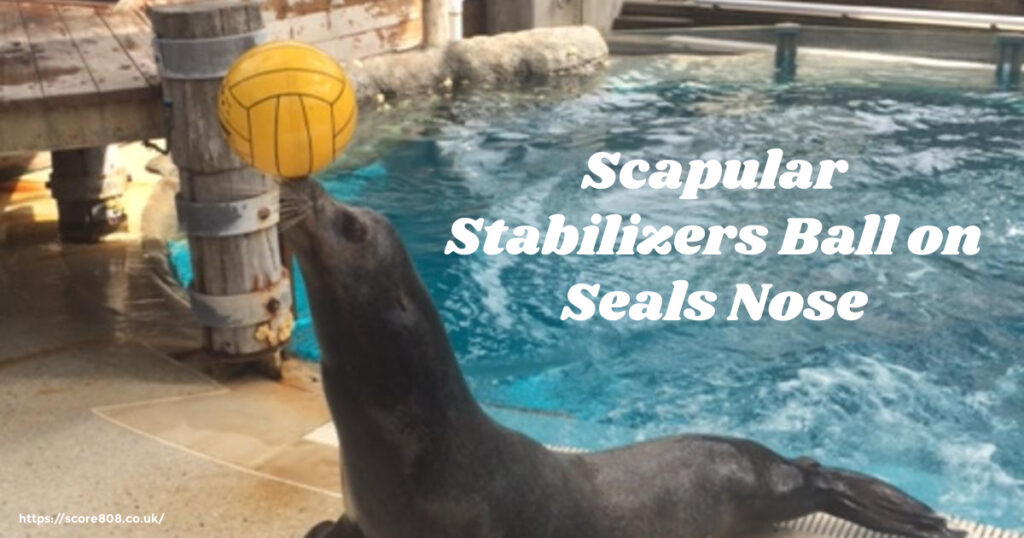Does your shoulder ache while maintaining your lower back? Are you struggling with shoulder stability throughout your workout routines, or is it recurring daily? Scapular stabilizers are the key to unlocking an ache-unfastened and more potent range of movement. When addressing these muscular tissues, the “Ball on Seal’s Nose” exercise is a revolutionary and powerful method that would transform your schooling regime.
Whether you’re an athlete searching for peak performance, a fitness fanatic working to your shape, or a physical therapist helping customers get better, this weblog will walk you through the function of scapular stabilizers, their significance, and how to harness the precise advantages of this easy yet revolutionary workout.
What Are Scapular Stabilizers?
The scapula, or shoulder blade, assists arm motion and balances the upper frame. But what keeps the scapula functioning correctly? Scapular stabilizers are a set of muscular tissues that anchor the scapula and enable easy, controlled movement.
These key muscle tissues encompass:
- The trapezius (top, center, and decrease portions)
- Rhomboids (major and minor)
- Serratus anterior
- Levator scapulae
These paintings together to ensure the scapula moves in sync with the arm. Dysfunction in these muscle tissues can lead to lousy shoulder mechanics, aches, or damage.
Why Do Scapular Stabilizers Matter?
Strong scapular stabilizers are essential for athletes and health fans. They increase shoulder stability and lessen the threat of injuries, such as rotator cuff problems or shoulder impingement. Weak stabilizers can compromise performance, affecting lifting, swimming, throwing, or basic pushing and pulling actions.
What Happens When Scapular Stabilizers Aren’t Strong Enough?
When scapular stabilizer muscle mass is vulnerable or imbalanced, the signs and symptoms can range from slight discomfort to more intense issues:
- Pain between the shoulder blades or within the top lower back
- Limited range of movement within the shoulder joint
- Poor posture, along with rounded shoulders
- Increased threat of rotator cuff injuries
- Reduced strength in activities that require pushing or pulling
The “Ball on Seal’s Nose” Exercise for Scapular Stabilizers
The “Ball on Seal’s Nose” workout is more than just a laugh, visual call! This modern movement engages the scapular stabilizers in a dynamic yet managed way, focused on the muscle groups while requiring stability, coordination, and consciousness.
But why the precise name? Imagine a seal balancing a ball on its nostril in a circus act—this workout mimics the delicate coordination and manipulation needed for that movement. Plus, it adds a playful twist to applicable health!
How to Perform the Ball on Seal’s Nose Exercise
Start with the setup:
- Use a gentle, inflated ball about 6–10 inches in diameter (like a Pilates or remedy ball).
- Lie inclined (chest down) on an exercise bench or balance ball to support your torso, and your fingers flow freely.
Engage the scapular stabilizers:
- Place your hand on the ball and gently press it toward the floor or desk. The key is to keep your center engaged and your shoulders stable.
Perform small, managed circles:
- Slowly move the ball in small circles using your hand while maintaining stability on the shoulder joint. This dynamically engages your scapular stabilizers.
Switch aspects and repeat:
- Repeat the motion on the other facet, ensuring regular form.
Optional progression for superior customers:
- Perform the workout on an unmarried leg or with restricted torso support to boom balance needs.
Remember to keep shoulder motion easy and avoid shrugging or pinching your shoulder blades together. Focus on managed, deliberate actions. Proper execution is vital to obtaining the full benefits of this exercise.
Benefits of the Ball on Seal’s Nose Exercise
- Strengthens key stabilizing muscle tissues of the scapula.
- Improves shoulder mechanics for smoother arm movement.
- Enhances coordination and neuromuscular manipulation.
- Reduces the risk of shoulder accidents during sports activities or workouts.
- Adds a fun and challenging dynamic to your habit.
Complementary Exercises for Scapular Stabilization
While the “Ball on Seal’s Nose” workout is mighty, it’s pleasantly paired with other actions for comprehensive scapular balance. Here are a few to consist of on your schooling:
Wall Angels
- A terrific beginner flow to interact with the serratus anterior and enhance shoulder mobility.
Scapular Push-ups
- It targets the serratus anterior, even as selling scapular protraction.
- Y-T-W Raises
- Focus on strengthening all quantities of the trapezius for balanced scapular manipulation.
Face Pulls with External Rotation
- Activates the rhomboids and rear deltoids for better posture and pulling power.
Serratus Wall Slides
- A dynamic exercise is needed to target the serratus anterior and sell proper scapular positioning.
Building Consistency and Progression
Consistency is the secret to strengthening your scapular stabilizers. Incorporate those physical activities into your weekly recurring, starting with 2–3 classes in line with the week. Gradually boom depth by including resistance bands, weights, or time below tension.
Tracking your development matters, too! Keep a document of how your shoulder feels throughout everyday sports or workouts, and be aware of upgrades in pain reduction or energy over the years.
Real-Life Success with Scapular Stabilizer Training
Numerous athletes and health lovers have experienced life-converting results, specializing in their scapular stabilizers. Here’s a quick instance:
“After months of struggling with shoulder aches, I introduced the Ball on Seal’s Nose exercise to my recurring. Within weeks, I observed decreased discomfort and improved stability in my bench press. It’s now a staple in my training!” —Mike, leisure powerlifter.
These simple, focused movements can make a global distinction.
Take Action for Pain-Free, Stronger Shoulders Today
The Ball on Seal’s Nose exercise is a game-changer for everyone seeking to build strong, healthy shoulders. Concentrating on regularly neglected scapular stabilizers can restore imbalances, improve shoulder mechanics, and prevent injury.
Dive into your schooling with enthusiasm and adventure—your shoulders will, thank you!
Do you have questions? Are you looking for customized recommendations? Send us a message or share your favorite scapular sporting events in the remarks below. Let’s construct healthier, more muscular shoulders collectively!




